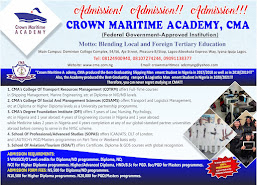Gender Inclusion: NSML Targets 15% Increase In Female Seafarers Within Five Years
…“Our Vessels Have the Highest Number of Female Seafarers in Nigeria” - Abdulkadir Ahmed
Kathy Kyari
With a 3% rate of female seafarers globally, the MD/CEO of the NSML, Mr Abdulkadir Ahmed, has said they are seeking to increase the number of female seafarers on their Vessels to 15% in the next five years.
Speaking with Anchor Press in an interview recently, Abdulkadir said the contracts and difficulties of being at sea are some of the reasons for the low rate of female seafarers globally.
According to him, there have been concerted efforts at attracting the female gender into seafaring, while claiming that the NSML have taken the lead in the fight for gender inclusivity in the shipping industry by employing the highest number of female seafarers in Nigeria.
“I am a diversity champion and sponsor within the entire group. Unfortunately, our industry has been too male centric over the years.”
“Globally, less than 3% of the seafarers are women and I say globally. So it's not just simply a Nigerian problem, it is not an NSML issue, it's a global issue. And there are reasons behind that, the contract, the sea, you know being at sea. It's difficult in the simplest of all terms.”
“We at NSML are taking the lead in Nigeria. In terms of the average number of female seafarers on our fleet, we are slightly above, at the moment, the global average, which is not good enough.”
The MD/CEO stressed that the NSML has zero tolerance for sexual harassment & bullying, and that they are working towards increasing the number of female seafarers on board their vessels to a groundbreaking 15% in the next five years.
“Let me be open and frank about that, it's not good enough. And therefore I have always said diversity is an active term, it's not a passive term. It's not something you just wish, you have to act upon it. And we've started that process.”
“So we have targets, and the target for us in the next five years is to push towards having at least 15% of our seafarers being female. I said the next five years. And what are we doing in that respect? You can't just plug them from the air. You have to start from the bottom, and Effiong will tell you that currently when it comes to cadets that go on our vessels, over 25% are female. That's a starting point. Over 25% from our cadetship programme are female.”
“After that, you have to create the conditions for them to want to be at sea. And that comes into the condition of service, harassment and bullying policy which we've put in place, we have zero tolerance when it comes to sexual harassment, the PPEs, the uniforms.”
“Hitherto, you go on board and see a lady wearing a man's boot and coveralls, we have changed all of that to ensure that there is gender sensitive equipment on board.”
“You will be surprised, even the simplest of all things as sanitary wares. Before now, because it was a male centric environment, nobody thought about that. But we've had to start focusing on those little things to make it comfortable for women to be at sea. It is difficult as it is, but we shouldn't make it more difficult for them. So we are starting at all of those little things that you need to put in place. One, to attract them but most importantly to make them want to stay at sea. And I'm glad to say so far, we are doing very well.”
According to Abdulkadir, the cadetship programme is a pool of recruitment for the NSML as over 25% of cadets that come on their vessels for the cadetship programme are female.
“We like it because we at least know them from when they were cadets. They trained on our vessels. So we know their temperament and capacity. When they finish their COCs and if I'm going to employ them, I have a space, of course the first person I'd consider would be the ones that have gone on my vessels.”
“One of the things I've made very clear to the manning and crewing team is for any lady that finishes and wants a job, we'll create one, provided she has the right certification and the right temperament. Like I said, the target for the next five years is to increase the number of females on our fleet to 15%. That would be groundbreaking. And it's not going to be easy. Because like I said, industry wide, it is around 3% today.”


















0 Comments